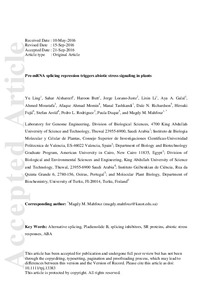Pre-mRNA splicing repression triggers abiotic stress signaling in plants
Magdy M. Mahfouz; Lixin Li; Haroon Butt; Dale N. Richardson; Aya A. Galal; Jorge Lozano-Juste; Ahmed Moustafa; Manal Tashkandi; Afaque Ahmad Momin; Sahar Alshareef; Stefan Arold; Paula Duque; Pedro L. Rodriguez; Yu Ling; Hiroaki Fujii
https://urn.fi/URN:NBN:fi-fe2021042716103
Tiivistelmä
Alternative splicing (AS) of precursor RNAs enhances transcriptome
plasticity and proteome diversity in response to diverse growth and
stress cues. Recent work showed that AS is pervasive across plant
species, with more than 60% of intron-containing genes producing
different isoforms. Mammalian cell-based assays have discovered various
AS inhibitors. Here, we show that the macrolide Pladienolide B (PB)
inhibits constitutive splicing and AS in plants. Also, our RNA-seq data
revealed that PB mimics abiotic stress signals including salt, drought,
and abscisic acid (ABA). PB activates the abiotic stress- and
ABA-responsive reporters RD29A::LUC and MAPKKK18::GUS in Arabidopsis thaliana
and mimics the effects of ABA on stomatal aperture. Genome-wide
analysis of AS by RNA-seq revealed that PB perturbs the splicing
machinery and leads to a striking increase in intron retention and a
reduction in other forms of AS. Interestingly, PB treatment activates
the ABA signaling pathway by inhibiting the splicing of clade A PP2Cs
phosphatases while still maintaining to some extent the splicing of
ABA-activated SnRK2 kinases. Taken together, our data establish PB as an
inhibitor and modulator of splicing and a mimic of abiotic stress
signals in plants. Thus, PB reveals the molecular underpinnings of the
interplay between stress responses, ABA signaling, and
post-transcriptional regulation in plants.
Kokoelmat
- Rinnakkaistallenteet [19207]
